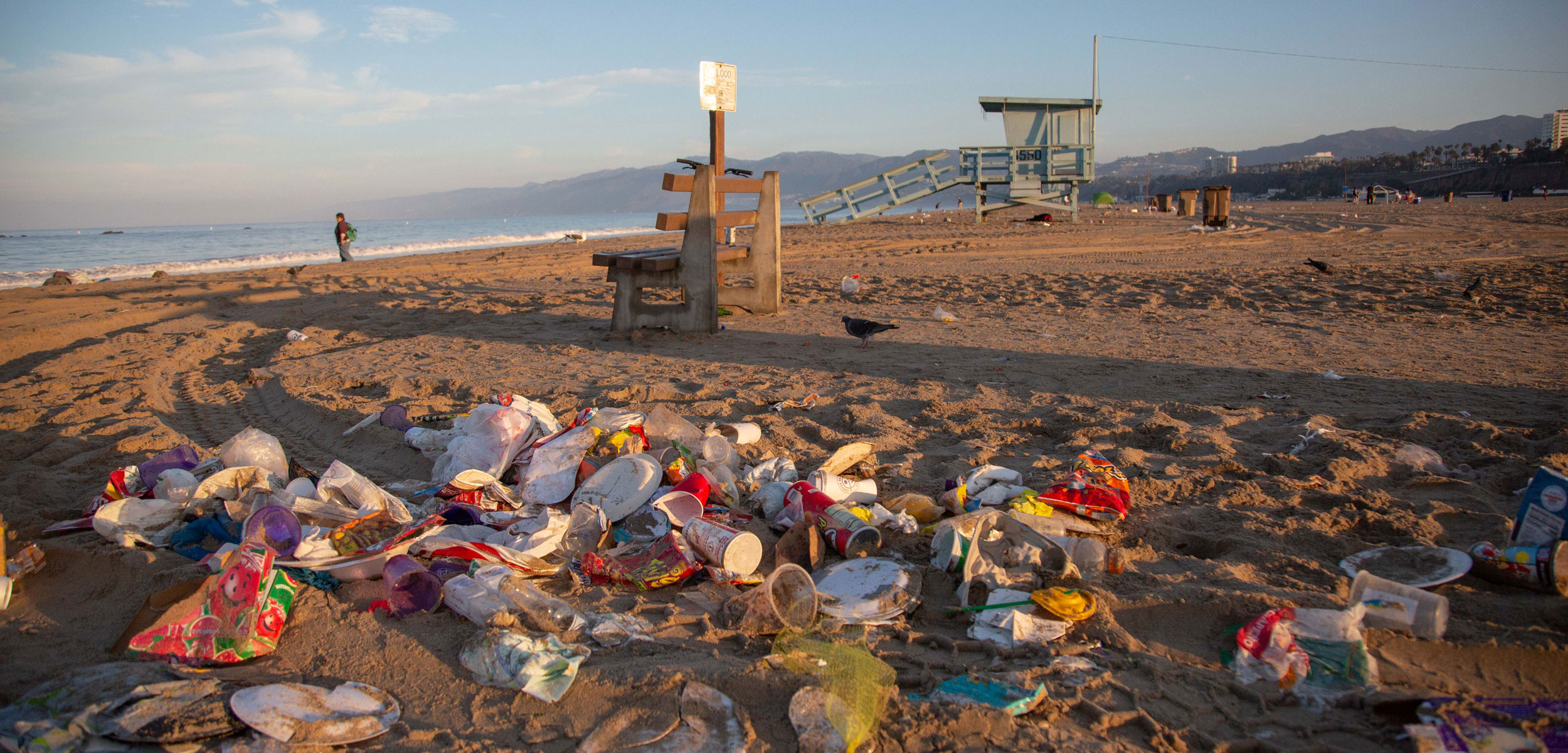Groomed to Death
Urban beaches around the world have less garbage than remote beaches, but less life too. The City of Santa Monica hopes to change the image of a clean beach.
Article body copy
As Gavin Andrus takes a seat at the helm of a green John Deere tractor, it’s still dark out at the Santa Monica Pier. The stationary Ferris wheel is silhouetted against the city sky, and unseen waves crash against the pilings and lap against the sandy shore. The rhythmic onslaught brings with it the flotsam and jetsam of modern society: plastic grocery bags, cigarette butts, straws. Some of this refuse may have been expelled from the city storm drains. Some of it may have been cast off by thoughtless beachgoers the day before. And some of it may have been borne on the currents, washing in from Mexico or Japan or who knows where.
For the next five hours or so, Andrus’s job is to clean up as much of it as possible before the crowds arrive. He has the south side of the pier. Two other tractors will take care of the north. “Grandma needs a new facelift every day,” he tells me when I hop in the cab with him a little after sunrise. Behind him, the rake attached to the tractor kicks up a kaleidoscope of colored plastic and broken glass, churning in a vortex of liquified sand.
Andrus is a California boy in his mid-50s with the kind of bemused how-could-I-get-so-lucky-to-spend-my-whole-life-on-the-beach attitude that makes people living in colder climes curse. “I’m not the kind of person to sit behind a desk,” he says, gazing at the breaking waves from inside his glass-walled cab as he tunes in to the morning radio. Lest you think his job sounds a little too copacetic, consider that the sealed cab is necessary to protect him from the fine particles stirred up outside. Breathing those in day in and day out can cause silicosis, the lung disease known as potter’s rot or gravedigger’s disease. How about beach-groomer’s lung? Andrus doesn’t want that. “It’s terrifying,” he says.

Gavin Andrus drives a John Deere tractor across his section of the 5.6-kilometer-long Santa Monica State Beach, collecting everything from condoms to diapers. Photo by Kyle Grillot
The other great occupational hazard Andrus faces is running over a person at this wee hour. Off to his left, near a lifeguard station, a homeless man is cocooned in a sleeping bag—far from the only one he’ll see this morning. “Obstacles,” Andrus says. When it’s still dark and foggy, people can come out of nowhere drunk or tired or just not paying attention. “You’ve really got to be on your game down here.”
With each pass of his section of the 5.6-kilometer-long beach, he makes a loop away from the shoreline and flicks a lever, depositing garbage—a single, sad sandal on this pass—in a growing windrow, the speed bump of debris he leaves behind for a specialized vehicle to vacuum up and filter. “Everything shows up in a windrow,” he says. “You name it. From condoms to toys to money. Occasionally, jewelry.”
He jokes about painting baby diapers on the front of the tractor, like a Second World War fighter pilot memorializing the enemies he’s shot down. He would soon run out of canvas though—gathering a dozen or more nappies on a summer day is not unrealistic. Sticking out of the vents on his dashboard are two rubber killer whales retrieved from a windrow. Not that he’s a scavenger. Andrus just notices things sometimes. He circles around to make another pass along the beach as the morning’s first yoga class convenes for sun salutations.
Santa Monica State Beach, considered by some as the birthplace of beach volleyball, ranks among the busiest in California. As many as 50,000 people flock to this stretch of coastline on a typical summer day, and, at its widest, the beach could potentially accommodate more than 30 volleyball courts. Visiting a freshly raked urban beach like this, few people realize that it can amass over 10,000 kilograms of trash during a busy summer week. After the Memorial Day holiday in May 2015, cleaning crews gathered 39,862 kilograms. That’s the equivalent of 800 North Pacific giant octopuses. If Andrus and his coworkers failed to show up for a month, the beach would start looking like a dump.

Families are setting up for a day at the beach as a specialized vehicle rolls by, vacuuming up yesterday’s waste. Photo by Kyle Grillot
While the US $3.3-million the city spends each year maintaining its beaches is undoubtedly good for keeping the tourist dollars rolling in and protecting some of the local marine life, there are some unfortunate side effects to all this cleanliness. Out of sight means out of mind, and when a city sweeps its pollution away, urbanites lose their biggest and best indicator of how much trash is in our oceans and befouling remote shores they rarely visit. “If they don’t see it, they don’t think it’s a problem,” says Heike Lotze, a marine ecologist at Dalhousie University in Halifax, Nova Scotia, who has studied the perception of marine threats around the world. And grooming itself has some unintended environmental consequences. When sweepers flatten the contours of the beach and strip the shoreline of the wrack—the rotting mess of kelp and seagrass that washes up—they turn a living beach into a sterile sandbox. When the beach hoppers and kelp flies vanish, so too do the shorebirds, including plovers and killdeer.
For most of us, the idea of the perfect beach calls to mind an episode of Baywatch or a glossy advertisement for a Royal Caribbean cruise. For decades, Hollywood has fed us a diet of suntans, surfboards, and vast expanses of sand as sterile and white as the communities featured. One by one, coastal hamlets lapped up that aspirational vision of purity, stripping their beaches of anything that trespassed on them. Today, this is changing as cities look for the right balance between clean beaches and healthy beaches. Santa Monica, which had no small part in perpetuating this outdated clean dream, is now one of the leaders in progressive beach grooming strategies. The city is redefining what a clean beach looks like and is encouraging beachgoers to play along.
“It’s a natural environment,” Andrus says, “but it’s also a park.” He points out a couple of swallows swooping down to collect flies from the mass of seaweed by the water. “We don’t touch the seaweed down there.”
People produce a staggering amount of waste. Globally, it amounts to about 1.3 billion tonnes per year, a number expected to increase to 2.2 billion by 2025, according to a World Bank report. A significant amount of that waste is plastic, with an estimated five to 13 million tonnes entering our oceans each year. Most of us have heard about the Great Pacific Garbage Patch, that cloudy stew of chemical sludge and degrading plastic particles estimated to cover an area twice the size of Texas, but few of us have ever seen it.

Bird footprints weave through a pile of trash a cleaner is collecting on Santa Monica State Beach. Birds often pick at the rubbish, which can become lodged in their throats and kill them. Photo by Kyle Grillot
Our beaches represent an interface where a local problem becomes a global one and vice versa. Most of the trash left behind on a beach eventually ends up in the ocean, and some of the trash in the ocean eventually ends up on a beach. When scientists recently visited Henderson Island, a 37-square-kilometer uninhabited island in the middle of the Pacific, they tallied up almost 38 million pieces of trash on its beaches, weighing nearly 18 tonnes. At other beaches around the world, where you’ll see nary a human footprint, you’ll almost certainly find abandoned fishing gear—plastic floats or nets—which accounts for almost half of marine debris in the Great Pacific Garbage Patch. Other kinds of trash may be carried in from countries with poor waste management practices—here’s looking at you, China—or where the country simply has a permissive culture of litterbugs.
It’s the kind of trash you won’t find much of on urban beaches. The effort that keeps popular shorelines clean is costly and constant.
Santa Monica, like many coastal cities, began beach grooming in the late 1950s—around the time plastic entered widespread use. Back then, the city had a six-person crew cleaning five days a week along with a modified hay rake—someone had the idea to place screen wire between the tines. As hard as the cleaners worked, the piles of trash kept coming, just like the tides. In June 1990, the Los Angeles Times published what was then an alarming article titled, “The beaches are drowning in plastic.”
While the headline hardly comes as a shock today, this was the dawn of a growing environmental consciousness about the toll of plastics. According to the story, a statewide survey of 575 kilometers of coastline found that nearly 68 percent of beach trash in Los Angeles County was plastic. The more horrific anecdotes made the media rounds and alarmed the public far from California: discarded plastic rings used to hold six-packs of soda and beer were strangling birds and slicing into sea mammals. One interview subject described a dolphin that had washed up on the California shore a couple years earlier: “He seemed fine from all external indications. But when they cut him open they found eight pounds [3.6 kilograms] of garbage in his gut.”
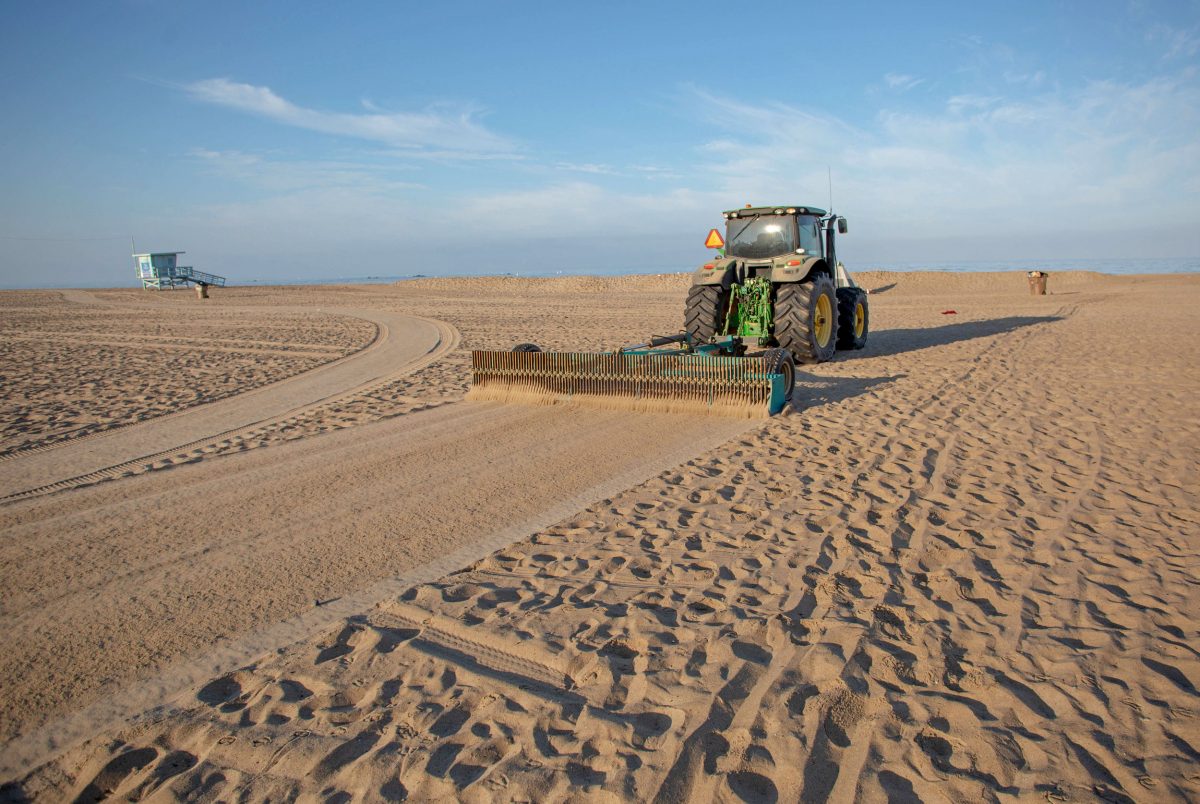
A rake attached to the back of a tractor leaves smooth sand in its wake, which is ideal for beachgoers but not for beach hoppers that get caught up in the tines. Photo by Kyle Grillot
Beachgoers alone were not to blame for all this urban litter. The sprawling county of Los Angeles has an equally sprawling network of storm drains underneath its streets—5,311 kilometers, according to one report. All the urban trash and pollution from the four million residents of the city and parts of the surrounding metropolitan area gets jettisoned into Santa Monica Bay. The city put inflatable dams and filters on waterways like Ballona Creek to catch some of the pollution. In 2000, it began testing continuous deflection separation devices, which create a whirlpool to separate water from grease and debris. The devices have helped, but there is still a lot more that could be done.
At least Neal Shapiro, a marine biologist in his 60s, thinks so. Shapiro has always been an ocean guy; he spent 10 years working on research and policy at the west coast office of the Cousteau Society before taking a job with the City of Santa Monica in 1999, where he oversees the watershed management program. He didn’t quite realize what he’d be getting into. That is, trash. “I don’t understand why people can’t put trash in the container,” he says. It is exasperating: litter accounts for about two percent of annual waste production in the United States, according to a 2009 survey.
In 2013, the City of Santa Monica established the somewhat audacious goal of eliminating 95 percent of all landfill-bound trash by 2030. They named it the Zero Waste Strategic Operations Plan, as though it were the latest NASA mission. Five years earlier, the city had eliminated non-recyclable plastic and styrofoam food containers and banned plastic grocery bags. The city tasked Shapiro with seeing how close they were getting to entirely eliminating trash on the beach.
The city already weighs the trash Andrus and the crew collects but to achieve its goal, it needed to know how much it was leaving behind. So every three months, and after holiday weekends, Shapiro visits the beach near the Santa Monica Pier. There, he lays out two 30-meter-by-30-meter grids and walks around collecting every piece of refuse he can find, from candy wrappers to bottle caps. He then brings it all back to his office, weighs it, and photographs it. Some of the most surprising items are compostable mango seeds wrapped in plastic bags, a sign that our idea of cleanliness is more often about us than about our environment. The total Shapiro collects near the pier rarely adds up to more than a couple kilograms, but roughly extrapolated over the entire beach, it means that the cleaning crew is potentially leaving behind more than 100 kilograms of trash after its sweep.
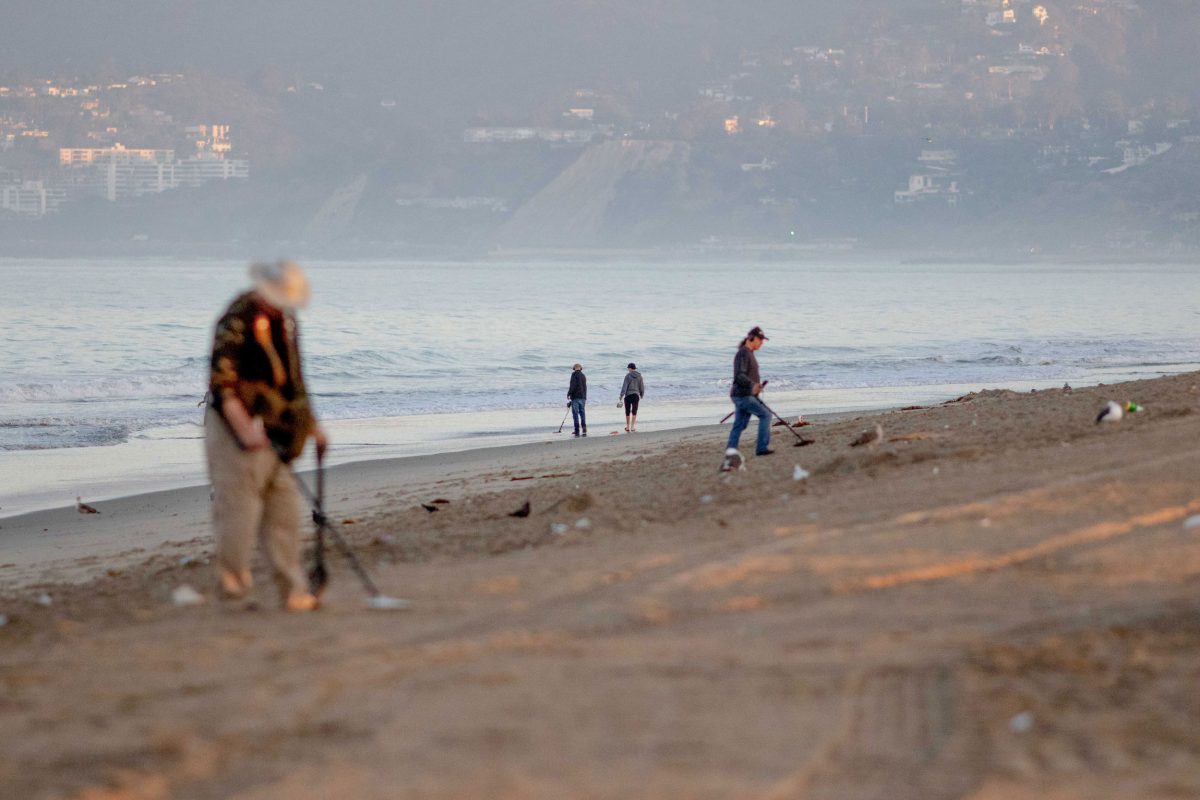
Treasures can be found amid the trash, and people with metal detectors try to grab the gems before they’re collected by the cleanup crew or washed out to sea. Photo by Kyle Grillot
Undeterred by the Sisyphean task of eliminating waste, Santa Monica is following in the footsteps of nearby Malibu—the place where surf culture went mainstream with the release of Gidget in 1959—with plans to ban plastic straws. The State of California is currently mulling a law requiring plastic caps to be tethered to bottles. Pesky things like straws, bottle caps, and cigarette butts account for up to 70 percent of Shapiro’s haul. In his view, the only way the city will eliminate litter completely is by doling out more $250 tickets. The hardened trash investigator thinks “carrots” are ineffective. “The stick is the answer,” he says.
While keeping our oceans and beaches clean of garbage is undeniably good for the environment, figuring out the best way to achieve that is complicated. Over 150 kilometers of Southern California beaches are regularly groomed, sometimes twice a day, and biologists and conservationists have begun to see the downside to tidiness.
You could call it the beach hygiene hypothesis. Just as humans may develop allergies from growing up germ-free, beaches are suffering from being too clean. Swept flat each day, the beach can become a biological desert, devoid of the rare plant and animal species that make the coastlines so special. Over two tonnes of decaying kelp get deposited on a kilometer of beach each day, a valuable resource for wildlife that is robbed by city cleanup crews on a daily basis.
Jenifer Dugan, a biologist with the Marine Science Institute at the University of California, Santa Barbara, has found that beach hoppers, 14-legged “garbage” cleaners that thrive on wrack, have been disappearing from the coastline. “What habitat is disturbed as much as those beaches in Santa Monica?” she asks. “No agricultural practice disturbs the fields twice a day.”
On ungroomed beaches and other areas with little human impact, beach hoppers’ population can reach 100,000 individuals for every meter of beach. And on each meter of beach, they’ll devour 20 kilograms of wrack each month. “The kelp gets vaporized!” says Dugan, who has watched it happen. But when the beach hoppers, isopods, and other invertebrates that subsist on the wrack disappear, shorebirds also go hungry. That’s why barren beaches in California lose birds like killdeer and the endangered western snowy plover. Grooming can also destroy the eggs of the grunion, an unusual fish that lays its eggs in the sand at high tide.
What this research is telling us is that we need to accept that healthy beaches can sometimes be a little messy. Sure, most people going to the beach just want a clean place to lay out their towel, but they may not even realize what they’re missing. “There’s a whole ecosystem that would survive here without beach grooming,” says Karina Johnston, the director of watershed programs at the Bay Foundation, a nonprofit organization founded to protect the Santa Monica Bay.
On a cloudy May morning, she’s come out to one particular stretch of beach to show me what an ungroomed beach looks like in an urban environment, and the answer is, in part, flowers. Hundreds of canary-yellow flowers—the blooms of beach evening primrose—dot the rippling contours of the low dunes here. It’s the site of a pilot rewilding project that Johnston has been shepherding for the past two years.
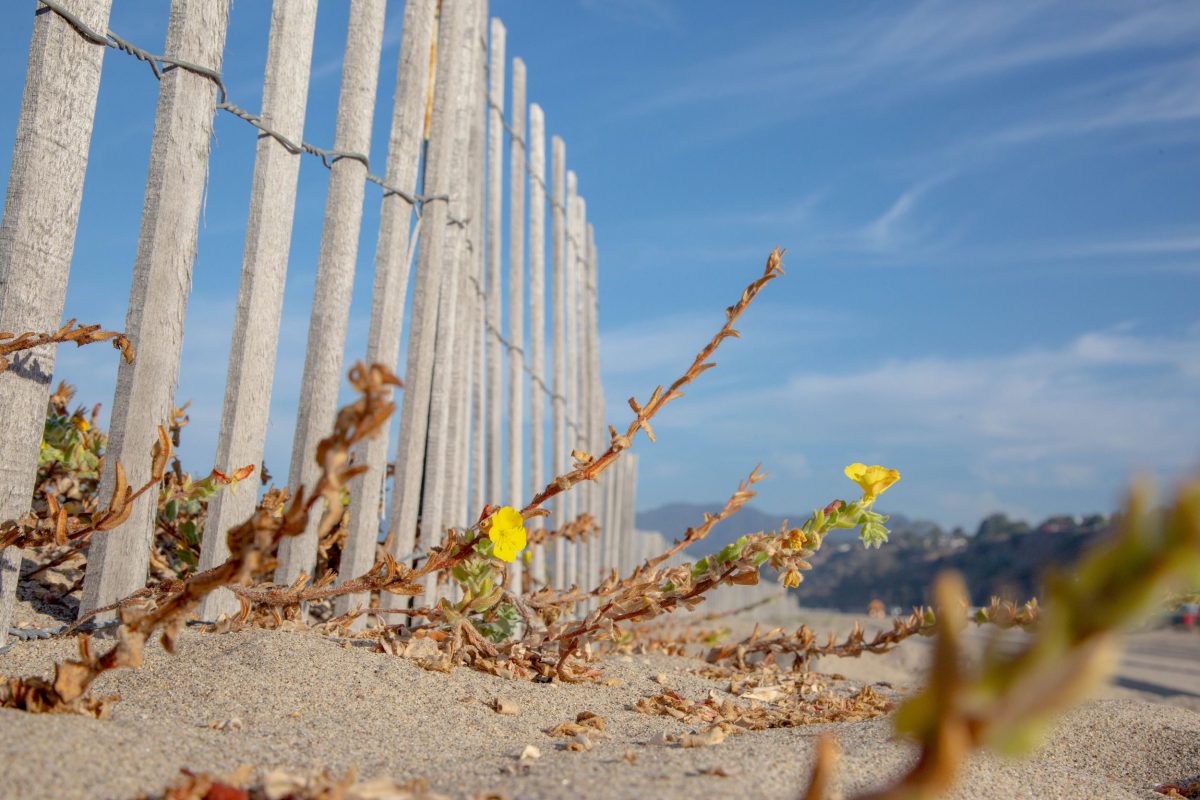
On one stretch of the Santa Monica State Beach, a fence has been erected to rewild the region. The project started two years ago, and today, beach evening primrose is thriving. Photo by Kyle Grillot
In December 2016, the Bay Foundation, in partnership with the City of Santa Monica, erected a wooden sand fence on this section of the beach—a little larger than a stadium-sized soccer field—to keep the groomers out and encourage the formation of dune hummocks. Next, the organization seeded the sand with native plants, including primrose and sand verbena. These plants had been largely extirpated from the Los Angeles region until this project began. Remarkably, within four months of planting those seeds and putting up the fences, Los Angeles County also got its first western snowy plover nest in more than 70 years.
Over the next several years, Johnston says, these dunes could grow to be up to a meter high, providing protection from coastal storms, and they will keep pace as sea level rises in the face of climate change. Importantly, the restoration area is open to beachgoers—one side has no fence. “One of the goals was to see if a project that was a real benefit to the ecosystem and to wildlife could also benefit people,” she says. Visitors can throw their blankets on the dunes and relax in a more natural environment than near the pier amid the thrumming crowds. Interpretative signs teach them about the local flora and fauna.
As Johnston’s talking, she casually reaches over to nab a plastic Hershey’s bar wrapper. “It actually stays very clean here,” she says apologetically. The area where the project is located, toward the western end of Santa Monica, doesn’t have to contend with as many visitors as the beach around the pier, where the bulk of the parking is. Even so, it seems to be cleaner than expected. Maybe people just feel guilty about tossing a cigarette butt next to a flower? Its colorful petals are a reminder that people aren’t the only living things that depend on our beaches.
A little after 10:00 a.m., as the sweepers finish their shift, Francisco Flores and David Mayorga hop out of their Gator utility vehicle and slap on blue rubber gloves. They’re both locals. Flores is a skinny guy in his 20s. Mayorga is in his 40s and a bit thicker around the waist. They’re wearing pants and blue long-sleeved shirts, and each has one of those trash-picker claws in one hand and a heavy-duty trash bag in the other.
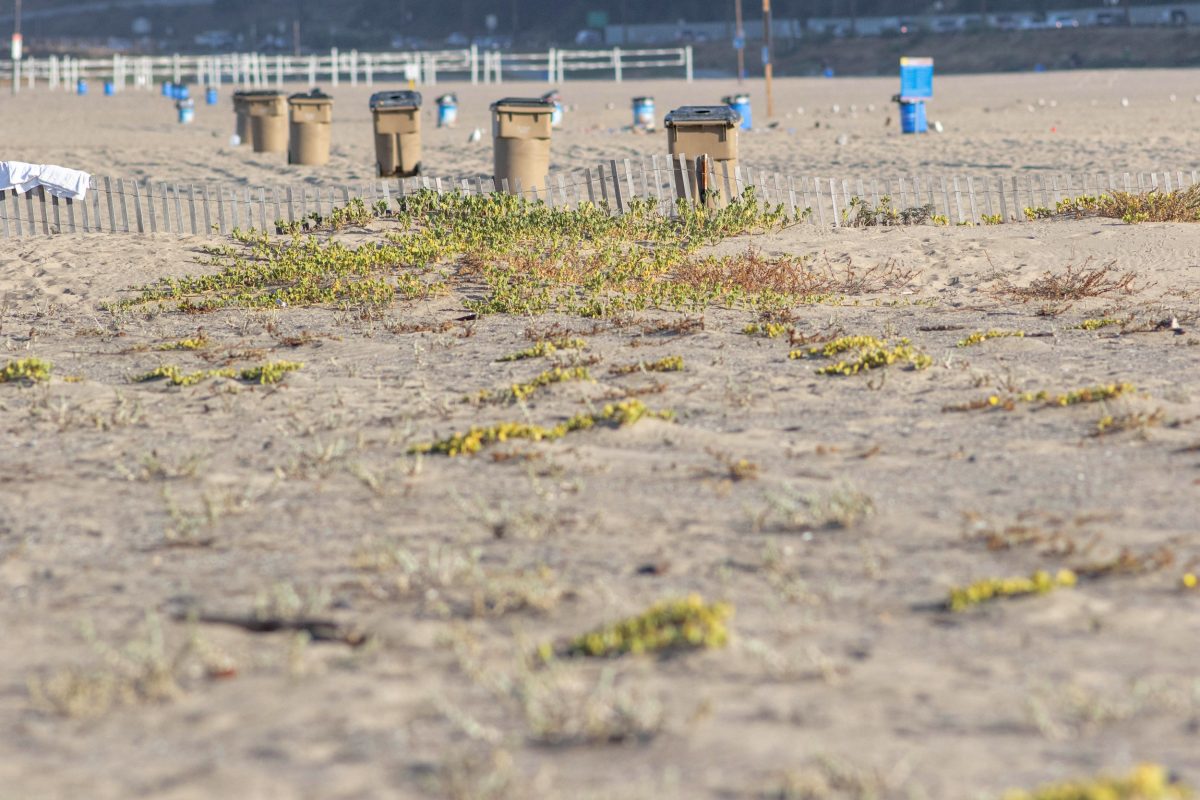
One beach, two ecosystems: on one side of the fence, native plants flourish, creating homes for birds and bugs; on the other, rows of garbage cans and volleyball courts await the throngs of beachgoers. Photo by Kyle Grillot
Beach cleaning is new to the men. They used to only be responsible for keeping the restrooms tidy, and their new responsibility has exposed them to a little more fresh air and given them a personal sense of pride. “Honestly, I never thought we would pick up so much trash,” Flores says. Sometimes, the two men bring back seven full bags of trash, weighing nine kilograms each.
Mayorga pops a bottle cap into his bag and explains that they’re responsible for the stretch of beach below the high tideline where the groomers no longer sweep. He claws a clump of seaweed and examines it, before putting it into his bag. “We’re not allowed to touch it unless it’s dried up,” he says. “Seaweed provides food for the seagulls.”
Flores has also taught him to check that the seaweed he leaves has no hidden balloons or balloon string, which the birds will eat. “When he first told me that I thought he was joking,” Mayorga says. “Then, one time I saw a pelican flying with the string hanging out of its mouth.”
After an hour with the team, I head back up to the spot where the beach turns to pavement, my eyes now trained to home in on every candy wrapper, every bottle cap in the sand. For all the lives saved during Baywatch’s eleven seasons, there’s one scene that I’m pretty sure never happened—on camera, at least. That’s the moment when someone bends over, picks up a piece of trash on the beach, and curses humanity.

